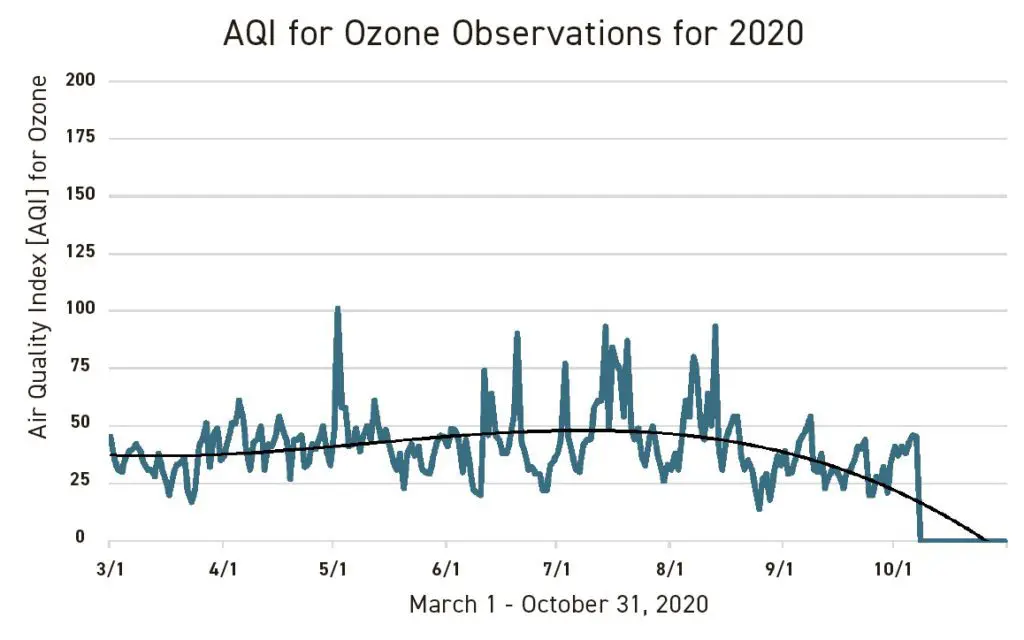The COVID-19 pandemic changed the look of our daily lives, as well as our world.
In cities around the globe, including metro Atlanta, many people sheltered in place to slow the spread of the virus. In Atlanta, we saw major declines in travel by April 2020, with mobility reduced to less than 40% of the median travel distance prior to the outbreak of COVID-19.
The sudden and ongoing stop of our activities, mostly commuting to work, helped scientists to see and measure exactly how our behaviors impact air pollution. It also reminded all of us that pollution is not a given that we have to accept.
With businesses reopening and COVID-19 vaccinations rolling out, traffic is increasing again. Environmental and health leaders worry that air pollution will return and may pass pre-pandemic levels as even more people drive alone to work to avoid shared commutes. The choices we make will have big impacts not only on our air quality, but our health.
Pandemic Air Quality
Throughout the spring and early summer of 2020, social media was full of stories about clean air, and newly visible skylines and mountain ranges. The proof of the shutdown’s impact on air quality was confirmed by researchers.
Satellite data and observations on the ground also showed related declines in greenhouse gases and some common air pollutants, especially nitrogen dioxide (NO2). NO2 is a harmful air pollutant released by cars, planes and manufacturing plants. It contributes to ground-level ozone, or “smog,” a visible brownish haze or cloud that can irritate the eyes and make it hard to breathe.
NASA researchers found that between February and November, pandemic restrictions reduced global NO2 concentrations by nearly 20% and, in some cities, by as much as 50%.
Metro Atlanta also experienced a big drop in ozone pollution during the pandemic. According to a report from the Atlanta Regional Commission, for the first time in 30 years, the region met the Environmental Protection Agency’s National Air Quality Standard for ground-level ozone.
Over the past four years, metro Atlanta has averaged nearly 14 days of ozone that went beyond Air Quality Index (AQI) standards. By comparison, 2020 had only one day ranking moderately unhealthy for sensitive groups. That’s a 93% decrease from where we’ve been, thanks to companies shifting to remote work and traffic plummeting by 40%.

View this chart to learn more about the Air Quality Index.

Source: Atlanta Regional Council, Transportation & Air Quality Committee Report. “Air Quality During COVID-19: Ozone in the Atlanta Region.” October 2020.
Why Air Quality Matters
Air pollution isn’t just what we see, like smoke from a wildfire. It impacts public health and overall quality of life.
Ground-level ozone and airborne particles (particulate matter) are the two pollutants that pose the greatest threat to our health. Every year they contribute to heart disease and asthma, and are responsible for more severe cases of COVID-19:
- Nearly half of Americans are living with unhealthy air
- From 2016-2018, Atlanta received an “F” for ozone pollution
- Air pollution contributes to 5 million premature deaths each year
- Particulate air pollution increases the risk of heart attack, stroke, arrhythmia and heart failure
- Daily exposure to higher levels of ozone is linked to increases in asthma attacks, hospital admissions and mortality
- Long-term exposure to poor air quality is also linked to higher death rates of COVID-19
- Nearly 9% of Georgia’s children have asthma
What We Can Do to Reduce Ozone
Trends suggest our improved air quality may be temporary, as traffic and emissions that add to smog are already rising.
Since we know that individual actions make an impact on our air quality, we can make a big difference in improving air quality by reducing emissions and making sustainable choices. Here are some small changes we can make in our daily lives:
- Choose a cleaner commute – telework, carpool, take transit, bike or walk when possible
- Choose clean, renewable electricity, if you can
- Reduce our energy consumption
- Combine errands to reduce “cold starts” of your car and avoid extended idling
- Encourage regulatory agencies to set more protective pollution standards
The Dirty Half Dozen: Major Air Pollutants
Carbon Dioxide (CO2)
CO2, a greenhouse gas, enters the air when burning fossil fuels for energy and transportation. The buildup of CO2 and other greenhouse gases is causing the Earth’s atmosphere to warm, resulting in climate change. It also increases smog and other pollution levels.
Carbon Monoxide (CO)
Vehicles that burn fossil fuels are the main sources of outdoor CO. It contributes to the creation of ozone and, at high concentrations, can be harmful, taking oxygen from vital organs.
Nitrogen Oxides (NOx) and Nitrogen Dioxide (NO2)
Burning fuel releases NOx and NO2 into the air and adds to the creation of acid rain, particulate matter and ozone.
Ozone (O3)
Ground-level ozone, often called “smog,” is created from burning fossil fuels or when chemical solvents evaporate. Ozone can reduce lung function, harm lung tissue and make respiratory conditions worse, including bronchitis, asthma and emphysema.
Particle Pollution (PM 10, PM 2.5)
The main cause of haze, these inhalable microscopic particles can cause serious health problems, getting into your lungs and bloodstream.
Sulfur Dioxide (SO2)
SO2 forms when sulfur-containing fuel such as coal, oil or diesel is burned. It contributes to particle pollution and can lead to respiratory problems.
Sources: Environmental Protection Agency; American Lung Association; Air Quality Now.
The Quality Index
The EPA’s Air Quality Index can tell you how clean or polluted the air outside is, along with related health effects. It’s based on a scale from 0 to 500. The greater the number, the greater the level of air pollution and the greater the health concern. Find the AQI for your community at airnow.gov.

Source: AirNow.gov
